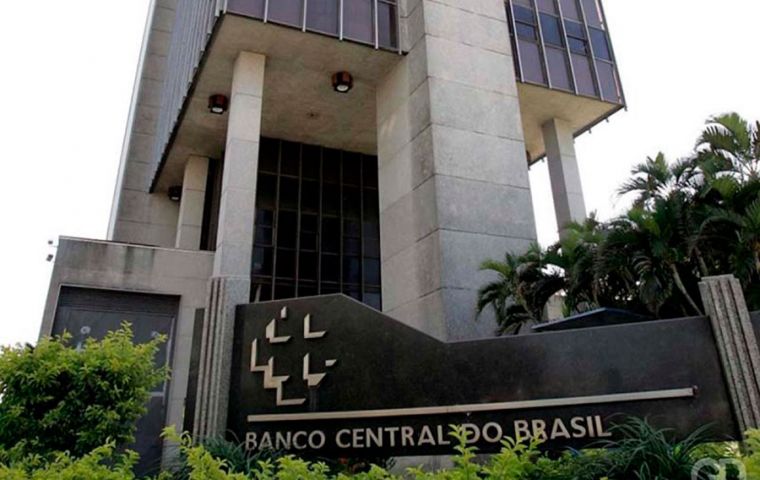MercoPress. South Atlantic News Agency
Brazil cuts basic interest rate to 12.25% per year
 The Selic rate is the BCB's main instrument for managing official inflation
The Selic rate is the BCB's main instrument for managing official inflation Brazil's Monetary Policy Committee (Copom) unanimously decided Wednesday to reduce the economy's basic interest rate (known as the Selic rate) by 0.5 percentage points to 12.25% per year, Agencia Brasil reported.
Wednesday's announcement was expected by financial analysts and the Brazilian Central Bank (BCB) cut interest rates for the third time in a row.
In a statement, Copom said that the international economy requires greater attention and caution from emerging countries in reducing interest rates. “The external environment is adverse, due to the rise in longer-term interest rates in the United States, the resilience of core inflation at still high levels in several countries and new geopolitical tensions.”
Despite the difficulties, the text said that Copom will continue to make further cuts of 0.5 points in the coming meetings. Copom, however, indicated that it may change the length of the cut period if conditions make it more difficult to reduce interest rates.
“The total magnitude of the easing cycle over time will depend on the evolution of inflationary dynamics, especially the components most sensitive to monetary policy and economic activity, inflation expectations, particularly those of a longer-term nature, inflation projections, the output gap and the balance of risks,” the text said.
The rate is at its lowest level since May last year when it was 11.75% per year. From March 2021 to August 2022, Copom raised the Selic 12 consecutive times, in a cycle of monetary tightening that began amid rising food, energy, and fuel prices. For a year, from August last year to August this year, the rate was kept at 13.75% per year seven times in a row.
Before the start of the upward cycle, the Selic rate had been reduced to 2% a year, the lowest level in the historical series that began in 1986. Because of the economic contraction generated by the Covid-19 pandemic, the BCB lowered the rate to stimulate production and consumption. The rate remained at its lowest level in history from August 2020 to March 2021.
The Selic rate is the BCB's main instrument for managing official inflation, as measured by the Broad National Consumer Price Index (IPCA). In September, the indicator stood at 0.26% and has accumulated 5.19% in 12 months. After successive falls at the end of the first half, inflation rose again in the second half of the year, but this increase was expected by economists.
The index ended last year above the inflation target ceiling. For 2023, the National Monetary Council (CMN) set an inflation target of 3.25%, with a tolerance margin of 1.5 percentage points. The IPCA, therefore, could not exceed 4.75% or fall below 1.75% this year.
In the Inflation Report released in late September by the Central Bank, the monetary authority maintained its estimate that the IPCA would close 2023 at 5% in the base scenario. The projection, however, may be revised downwards in the new version of the report to be released in December.
According to the Focus bulletin, a weekly survey of financial institutions published by the Central Bank, official inflation is expected to close the year at 4.63%, which is below the target ceiling. A month ago, market estimates stood at 4.86%.
The reduction in the Selic rate helps to stimulate the economy because lower interest rates make credit cheaper and encourage production and consumption. On the other hand, lower rates make it harder to control inflation. In its latest Inflation Report, the BCB increased its growth projection for the economy in 2023 to 2.9%.
The market is projecting similar growth, especially after the announcement that the Gross Domestic Product (GDP, the sum of the wealth produced) grew by 0.9% in the second quarter. According to the latest edition of the Focus bulletin, economic analysts forecast a GDP expansion of 2.89% in 2023.
The basic interest rate is used in government bond trading on the Special Settlement and Custody System (Selic) and serves as a benchmark for other interest rates in the economy. By adjusting it upwards, the Central Bank curbs the excess demand that puts pressure on prices, because higher interest rates make credit more expensive and encourage savings.
By reducing the basic interest rate, the Copom cheapens credit and encourages production and consumption, but weakens inflation control. To cut the Selic rate, the monetary authority needs to be sure that prices are under control and are not in danger of rising.
(Source: Agencia Brasil)




Top Comments
Disclaimer & comment rulesCommenting for this story is now closed.
If you have a Facebook account, become a fan and comment on our Facebook Page!